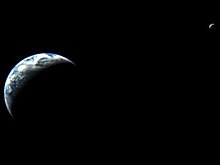Salimat-1
| Mission type | Satellite orbiting Stratos |
|---|---|
| Operator | Space Agency of Salamat, SpekeX |
| COSPAR ID | 2016-024A |
| SATCAT no. | 32122 |
| Website | https://www.salimat1.sl |
| Mission duration | 1 year |
| Spacecraft properties | |
| Manufacturer | SpekeX, Space Agency of Salamat |
| Launch mass | 1850 kg |
| Dry mass | 800 kg |
| Dimensions | 3.26m x 3.07m |
| Power | 1 800 watts |
| Start of mission | |
| Launch date | February 19 2016 17:22:04 UTC |
| Rocket | Valk-9 |
| Launch site | Wielek Launch Complex ,Speke |
| Contractor | SpekeX |
| Entered service | February 19 2016 17:29:44 UTC |
| Orbital parameters | |
| Peristrato altitude | 290 km |
| Apostrato altitude | 1,920 km |
| Inclination | 67.3° |
| Template:Infobox spaceflight/IP | |
Salimat-1 (Arabic : سالإمات-١ ) is an orbiter of the Salamati Space Program and the SpekeX Space Program launched on February 19 2016, and entered Stratoshian orbit on September 28 2016.
The mission design, development, and operations are led by the Abd El Fattah Al Salimat Space Centre (AFSSC). The spacecraft was assembled in Speke by the company SpekeX.
History
The idea for a Salamati mission to Stratos came from the president of Salamat Janub Mohamed Al Jumiyin, which announced that the development of the space program was one of his top priorities in May 2007. He announced the mission on June 12 2008 and declared that the project was aimed at enriching the capabilities of Salamati engineers, scientists and meteorologists and increasing human knowledge about Stratos. He declared in 2011 that the presence of hydrocarbons on the planet could boost the economy but affirmed that it isn't the goal of the mission.
The Space Agency of Salamat announced the collaboration with SpekeX on March 22 2010. The Space Agency of Salamat leading the design of the orbiter (with help of SpekeX, the development of the mission and the operations of the probe. SpekeX, on the other hand, takes care of the assembling of the probe, the launch and the transportation from the assembling building to the launchpad.
In January 2014, the SAS showed a prototype of the probe at the Dar Al Hamma space convention, revealing the shape of the orbiter for the first time to the general public. The orbiter is a cuboid, with dimensions of 3.26 meters on 3.07 meters. It has two 900 watts solar panels and a 1 meter wide high-gain antenna to communicate. It also has cameras, the most remarkable one is SABR, which can recognize objects on the surface whose width is greater than 500 meters. It also has multiple sensors.
The orbiter was finished on November 14 2015. It was transported from the assembling point to the launchpad on January 29 2016 and was launched on February 19 2016 at 17:22:04 UTC (16:22:04 Salamati time, 12:22:04 Speke time) at the Wielek Launch Complex in Speke.
Launch and interplanetary travel
The orbiter was successfully launched on February 19 2016 at 17:22:04 UTC (16:22:04 Salamati time, 12:22:04 Speke time) at the Wielek Launch Complex in Speke, aboard of a Valk-9 rocket, during a short launch window which started on February 16. The probe started communicating 7 minutes at 17:29:44 UTC (16:29:44 Salamati time, 12:29:44 Speke time) and sent an image of Anteria and the Moon at 19:11:50 UTC, making it the first image that the probe has taken.
The first Interplanetary Course Maneuver took place on March 16 2016, and the second one on June 29 2016.
The orbiter arrived at Stratos on September 28 2016 at 12:21:27 UTC (11:21:27 in Salamat and 07:21:27 in Speke. At around 11:45 Salamati time (UTC-1), the probe started firing its thrusters for about 21 minutes. The probe became silent then sent the confirmation that Salimat-1 entered Stratoshian orbit at 13:29:16 UTC on September 28 2016. Further orbital corrections were made in the following days.
Scientific goals
The primary goals of the probe are ;
- Cartographing the Stratoshian surface
- Analyze wind patterns, currents, river movements, local pressure differences, local temperature differences, dust movements, precipitations repartition, volcanic activity...
- Deduce atmospheric composition with a better precision
- To some extent, detect water ice.
